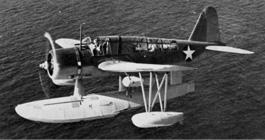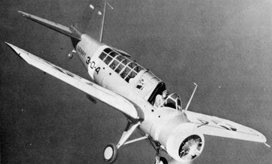Vought OS2U-3 Kingfisher






The Kingfisher was the U.S. Navy's first catapult-launched monoplane observation aircraft. It came in both float and land-based configurations, and served as observer aircraft, anti-submarine aircraft, and rescue aircraft. The most famous incident involving a Kingfisher was the rescue of Captain Eddie Rickenbacker, who ditched in the Pacific in a B-17 during 1942. A Kingfisher picked up Rickenbacker and two other crew members (who still remained following a rescue the previous day) but the Kingfisher could not take off because the load was too great. The OS2U pilot taxied on the surface over 40 miles to make the nearest landfall with everyone aboard.
Additional information on this aircraft
can be found at Wikipedia
here.
(updated February 2009)
Vought OS2U-3 Kingfisher
Type: observation aircraft Crew: 2: Pilot, observer/gunner Armament: one .30 cal forward firing machine gun one .30 cal rear firing machine gun two 100 lb.bombs, or 325 lb. depth charges Specifications: Length: 33' 10" (10.31 m) Height: 15' 1.5" (4.61 m) Wingspan: 35' 11" (10.95 m) Wing area: 262 sq. ft (24.34 sq. m) Empty Weight: 4123 lb (1870 kg) Max Weight: 6000 lb (2722 kg) max at takeoff Propulsion: No. of Engines: 1 Powerplant: Pratt & Whitney R-985-AN-2 Wasp Junior radial Horsepower: 450 hp Performance: Range: 805 miles (1296 km) Cruise Speed: 119 mph ( 292 km/h) at 5000 ft Max Speed: 164 mph ( 264 km/h) at 5500 ft Ceiling: 13,000 ft (3960 m)
If this page does not have a navigational frame on the left, click HERE to see the rest of the website.